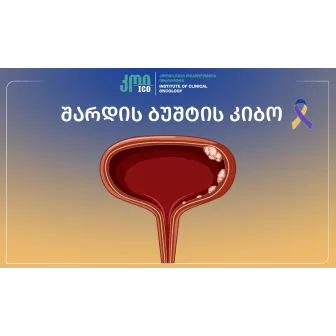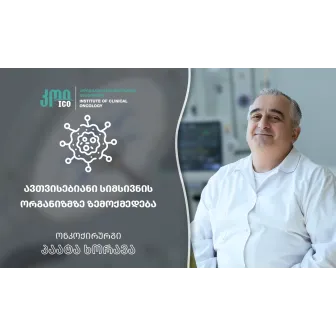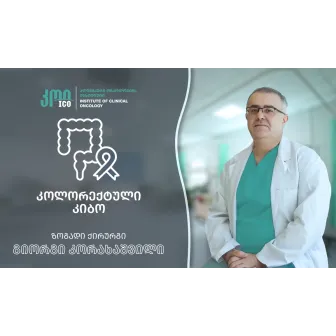Are you interested in what the symptoms of cervical cancer are, how it is diagnosed, treated, and what we should know about this disease? Tsitsi Meskhi, a doctor and oncogynecologist at the Institute of Clinical Oncology, talks to us about this topic.
Cervical cancer is the 3rd most common cancer among newly diagnosed cancer cases in women, with 85% of cases occurring in developing countries, and the 4th leading cause of death among women.
There are two main types of cervical cancer: squamous cell carcinoma and adenocarcinoma. Squamous cell carcinoma accounts for 80-90% of cervical cancers. The remaining 10-20% are adenocarcinoma and other types of cancer.
- At what age does cervical cancer most often occur?
Cervical cancer is a disease mainly affecting women of reproductive age and is caused by high-risk strains of human papillomavirus (16, 18, 31, 33, 35, 39, 45, 51, 52, 56, 58, 59, 66, 68). The most common are strains 16 and 18.
The disease is mainly spread through sexual contact.
- What risk factors contribute to the development of the disease?
- The main risk factors for the development of the disease are:
- Young age;
- Multiple sexual partners;
- Early onset of sexual activity;
- Smoking;
- Oral contraceptives;
- Genital infections;
- Low immunocompetence threshold;
- Uncircumcised partner
- What are the symptoms of cervical cancer?
Cervical cancer is characterized by early and late symptoms.
Early sympoms are:
· Vaginal discharge;
· Acyclic bleeding;
· Postcoital bleeding;
· Menstrual dysfunction;
· Menopausal bleeding.
Late symptoms include:
· Pain in the pelvis and back;
· Weight loss;
· Urinary and fecal incontinence (fistula formation).
However, it is very important and we must remember that this disease often has no symptoms!!
- How is cervical cancer diagnosed?
Disease diagnostics starts with a vaginal (macroscopic or microscopic) examination of the patient, assessing the condition of the vulva, vagina and cervix. Material is taken from the affected area (under the control of colposcopy) for cytological and morphological examination. After the verification of the disease, a complete radiological examination of the pelvis, abdominal cavity, and chest cavity is necessary to determine the spread of the disease and select adequate tactics for further treatment. At the same time, we study SCC (squamous cell marker) to control the dynamics of the disease.
- What types of treatment methods are available today?
The type of cervical cancer treatment depends on the stage of the disease. In the early stages, it is mainly surgical and its goals are:
- Effective treatment if the disease is localized;
- Excision of tumor tissue within healthy tissue;
- Removing of draining lymph nodes
In later stages, chemotherapy and radiation therapy are mainly used. After surgical treatment, chemotherapy and radiation therapy are indicated for:
- Positive lymph nodes;
- Initial tumor size > 4 cm;
- Deep stromal invasion;
- Lymphovascular invasion
- Parametrium demage;
- Poorly differentiated histological type;
- Close vaginal/parametrial margin.
In stage I-B and II-A of cervical squamous cell carcinoma, it is possible to preserve the ovaries. In the case of adenocarcinoma, it is not possible.
Both treatment methods (surgery, chemotherapy and radiation) have their advantages and disadvantages. The treatment method is selected individually for each patient, taking into account the stage of disease development, morphological type, patient's age, and somatic condition.
The most important issues in cervical cancer prevention are:
· Socio-economic development;
· Protection of women's rights and awareness raising;
· HPV vaccination;
· Screening;
· Early diagnosis and treatment.
HPV vaccination is an effective means of protection against cervical cancer. Almost 95-100% of those vaccinated develop protective antibody titers. There are bivalent and quadrivalent vaccines, and one of the main components of prevention is screening.
There are several methods of screening for cervical cancer:
· Cervical cytology - Pap test-based;
· Visual inspection with acetic acid and Lugol's iodine
· HPV testing.
HPV test is more sensitive than cytology and visualization.
The state program for prevention of cervical cancer based on cervical cytology-PAP test has been operating for about 20 years. Currently, HPV genotyping has also been launched.
PAP test, i.e., Papanicolaou test, is an important screening test for cervical cancer early diagnostics. The test was named after its discoverer, Greek physician Georgios Papanicolaou. It is a simple and painless method that allows us to detect precancerous conditions and cancer of cervix early, which in turn allows for proper and timely treatment and delays the progression of the disease.
80% of individuals infected with the human papillomavirus from their first sexual contact clear the virus on their own, while less than 20% develop a persistent infection, or a positive Pap test, 1 year after the start of sexual activity.
Persistent infection can develop into a productive infection - squamous cell intraepithelial lesion LSIL-CIN(I). This lesion can also regress in 80% of young women, and in rare cases, especially in women over 30 years of age, high-grade intraepithelial lesion - precancerous disease HSIL - can develop. If this lesion is not treated for 5-10 years, then the disease can progress. Some cases can regress without treatment.
Infection does not mean damage!!!
The expression of HPV E6 and E7 genes is crucial in the development of precancerous diseases, and biological markers help us identify them. Namely:
· P16 - the most informative marker of precancerous lesions;
· KI 67;
· Pro Exc.
- Views:10914

















